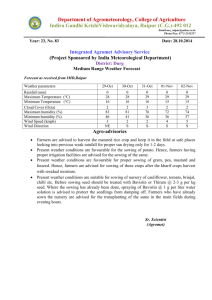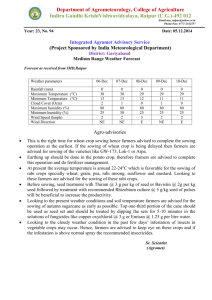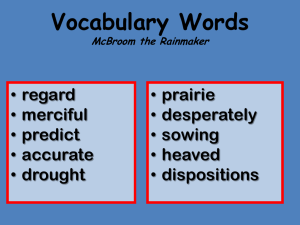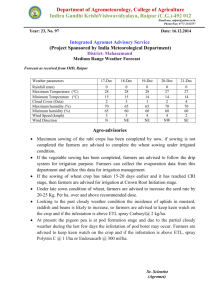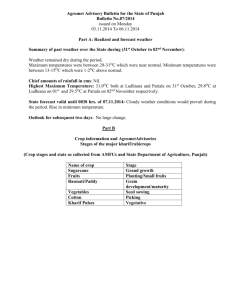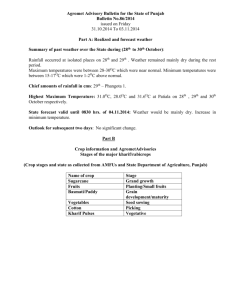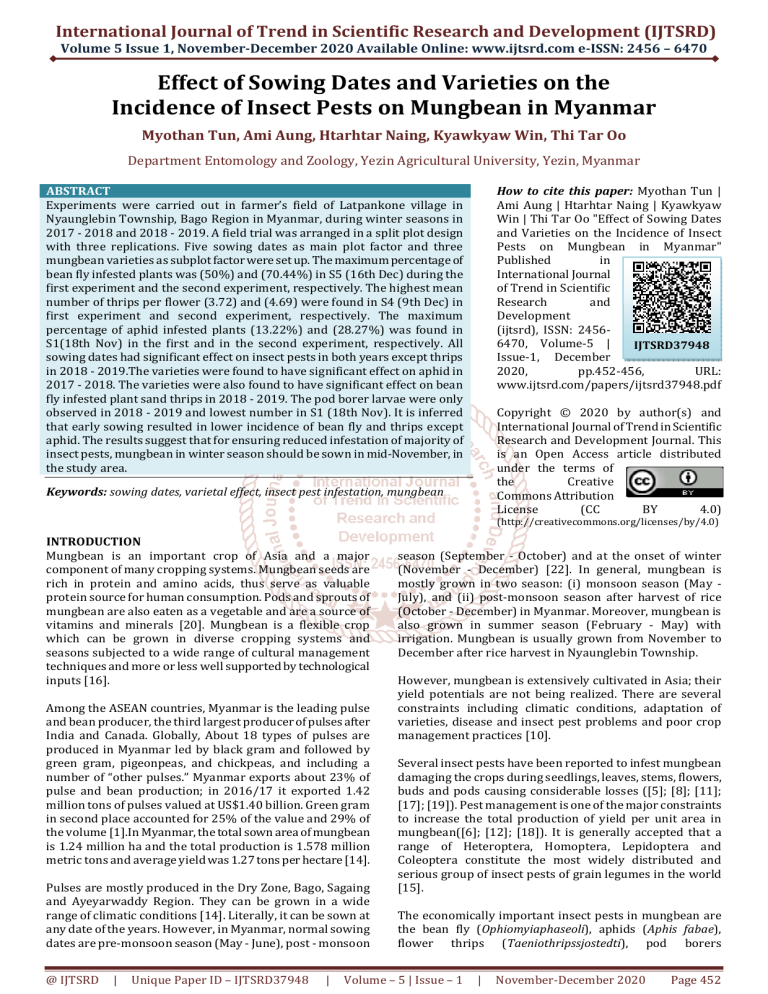
International Journal of Trend in Scientific Research and Development (IJTSRD)
Volume 5 Issue 1, November-December 2020 Available Online: www.ijtsrd.com e-ISSN: 2456 – 6470
Effect of Sowing Dates and Varieties on the
Incidence of Insect Pests on Mungbean in Myanmar
Myothan Tun, Ami Aung, Htarhtar Naing, Kyawkyaw Win, Thi Tar Oo
Department Entomology and Zoology, Yezin Agricultural University, Yezin, Myanmar
How to cite this paper: Myothan Tun |
Ami Aung | Htarhtar Naing | Kyawkyaw
Win | Thi Tar Oo "Effect of Sowing Dates
and Varieties on the Incidence of Insect
Pests on Mungbean in Myanmar"
Published
in
International Journal
of Trend in Scientific
Research
and
Development
(ijtsrd), ISSN: 24566470, Volume-5 |
IJTSRD37948
Issue-1, December
2020,
pp.452-456,
URL:
www.ijtsrd.com/papers/ijtsrd37948.pdf
ABSTRACT
Experiments were carried out in farmer’s field of Latpankone village in
Nyaunglebin Township, Bago Region in Myanmar, during winter seasons in
2017 - 2018 and 2018 - 2019. A field trial was arranged in a split plot design
with three replications. Five sowing dates as main plot factor and three
mungbean varieties as subplot factor were set up. The maximum percentage of
bean fly infested plants was (50%) and (70.44%) in S5 (16th Dec) during the
first experiment and the second experiment, respectively. The highest mean
number of thrips per flower (3.72) and (4.69) were found in S4 (9th Dec) in
first experiment and second experiment, respectively. The maximum
percentage of aphid infested plants (13.22%) and (28.27%) was found in
S1(18th Nov) in the first and in the second experiment, respectively. All
sowing dates had significant effect on insect pests in both years except thrips
in 2018 - 2019.The varieties were found to have significant effect on aphid in
2017 - 2018. The varieties were also found to have significant effect on bean
fly infested plant sand thrips in 2018 - 2019. The pod borer larvae were only
observed in 2018 - 2019 and lowest number in S1 (18th Nov). It is inferred
that early sowing resulted in lower incidence of bean fly and thrips except
aphid. The results suggest that for ensuring reduced infestation of majority of
insect pests, mungbean in winter season should be sown in mid-November, in
the study area.
Copyright © 2020 by author(s) and
International Journal of Trend in Scientific
Research and Development Journal. This
is an Open Access article distributed
under the terms of
the
Creative
Commons Attribution
License
(CC
BY
4.0)
Keywords: sowing dates, varietal effect, insect pest infestation, mungbean
(http://creativecommons.org/licenses/by/4.0)
INTRODUCTION
Mungbean is an important crop of Asia and a major
component of many cropping systems. Mungbean seeds are
rich in protein and amino acids, thus serve as valuable
protein source for human consumption. Pods and sprouts of
mungbean are also eaten as a vegetable and are a source of
vitamins and minerals [20]. Mungbean is a flexible crop
which can be grown in diverse cropping systems and
seasons subjected to a wide range of cultural management
techniques and more or less well supported by technological
inputs [16].
Among the ASEAN countries, Myanmar is the leading pulse
and bean producer, the third largest producer of pulses after
India and Canada. Globally, About 18 types of pulses are
produced in Myanmar led by black gram and followed by
green gram, pigeonpeas, and chickpeas, and including a
number of “other pulses.” Myanmar exports about 23% of
pulse and bean production; in 2016/17 it exported 1.42
million tons of pulses valued at US$1.40 billion. Green gram
in second place accounted for 25% of the value and 29% of
the volume [1].In Myanmar, the total sown area of mungbean
is 1.24 million ha and the total production is 1.578 million
metric tons and average yield was 1.27 tons per hectare [14].
Pulses are mostly produced in the Dry Zone, Bago, Sagaing
and Ayeyarwaddy Region. They can be grown in a wide
range of climatic conditions [14]. Literally, it can be sown at
any date of the years. However, in Myanmar, normal sowing
dates are pre-monsoon season (May - June), post - monsoon
@ IJTSRD
|
Unique Paper ID – IJTSRD37948
|
season (September - October) and at the onset of winter
(November - December) [22]. In general, mungbean is
mostly grown in two season: (і) monsoon season (May July), and (іі) post-monsoon season after harvest of rice
(October - December) in Myanmar. Moreover, mungbean is
also grown in summer season (February - May) with
irrigation. Mungbean is usually grown from November to
December after rice harvest in Nyaunglebin Township.
However, mungbean is extensively cultivated in Asia; their
yield potentials are not being realized. There are several
constraints including climatic conditions, adaptation of
varieties, disease and insect pest problems and poor crop
management practices [10].
Several insect pests have been reported to infest mungbean
damaging the crops during seedlings, leaves, stems, flowers,
buds and pods causing considerable losses ([5]; [8]; [11];
[17]; [19]). Pest management is one of the major constraints
to increase the total production of yield per unit area in
mungbean([6]; [12]; [18]). It is generally accepted that a
range of Heteroptera, Homoptera, Lepidoptera and
Coleoptera constitute the most widely distributed and
serious group of insect pests of grain legumes in the world
[15].
The economically important insect pests in mungbean are
the bean fly (Ophiomyiaphaseoli), aphids (Aphis fabae),
flower thrips (Taeniothripssjostedti), pod borers
Volume – 5 | Issue – 1
|
November-December 2020
Page 452
International Journal of Trend in Scientific Research and Development (IJTSRD) @ www.ijtsrd.com eISSN: 2456-6470
(Marucatestularis) and (Helicoverpaarmigera), bruchids
(Acanthosalidesobtectus) [7].
In the study area, most of the farmers usually sow the
mungbean just after the rice harvesting without considering
the optimum sowing dates. As a result of the crop growth
affected by unfavorable prevailing climatic condition and the
higher pest infestation, the high yield become uncertain.
Nowadays, farmers use various chemical insecticides to
control the insect pests. Despite the second most important
legumes for local consumption and export, the information
regarding the mungbean’s insect pest appearance and level
of damage in relation to sowing dates, is not much available
in Myanmar. In these regards, experiments were carried out
to determine the natural insect pest infestation level in
different sowing dates and on varieties of mungbean.
MATERIALS AND METHODS
The experiments were carried out at the farmer’s field of
Latpankon Village in Nyaunglebin Township, during the
winter season (November to March) of 2017 - 2018 and
2018 - 2019. The climate in general is wet monsoon climate.
The total annual rain fall of the region is 3,484 mm and 3,416
mm in 2017 - 2018 and2018 - 2019, respectively [13].
The experiment was arranged in split plot design with five
sowing dates as main plot treatment and three mungbean
varieties as subplot treatment with three replications. The
treatments were randomly allotted in each block. The main
plot factor (sowing date) consisted of five levels. They were:
S1: Sowing on 18th November
S2: Sowing on 25th November
S3: Sowing on 2nd December (normal sowing date)
S4: Sowing on 9th December
S5: Sowing on 16th December
There were three tested varieties as sub plots. They were Y1(Yezin-1), Y-11 (Yezin-11), and Y-14 (Yezin-14). The crop
maturity is Yezin-1 (70-75 days), Yezin-11 (60-65 days) and
Yezin-14 (60-65 days) (Department of Agricultural Research
[DAR], 2019).
The final land preparation was done on15 November 2017,
2018 in both growing seasons. Compound fertilizer (15: 15:
15) 150 Kg per hectare and cow dung manure 5 tons per
hectare were applied as basal fertilizer to the experimental
plots. The plots were prepared one day before seed sowing.
The agricultural practices such as irrigation and weeding,
applied in this experiment were similar to those commonly
adopted by local farmers. The seeds were sown in rows in
the furrows having a depth of 3-4 cm. Row spacing was 30
cm and plant spacing was15cm. The experimental plots were
maintained the margins at a large distance from the
surrounding fields to make sure that the insecticides sprayed
to other fields do not affect the study plots.
poor plant growth, leaf chlorosis, premature defoliation and
death: stems thicker than normal with crack above soil, were
recorded as infested plants. Even though the number of
larvae and pupae found in the stem of the infested plants has
been counted, it wouldn’t be mentioned and discussed in this
paper. Thrips population was collected from random20
opened flowers from each sub plot. The collected flowers
were immediately put in plastic boxes containing alcohol
soaked cotton balls to kill the thrips for easy counting of
their population. Sampling was started from 49 DAS until
harvest. For aphids, the number of aphid infested plants
(more than 20 aphids per plant) was randomly counted on
10 sample plants to record the infested plants throughout
the growing season until harvest. The number of spotted pod
borer larva was collected on shoot tips, flower buds, flowers
and pods by collecting all available stages of 10 random
plants.
The collected data were analyzed by using Statistix (version
8.0) and means were separated by using least significant
difference (LSD) test at 5% level.
RESULTS AND DISCUSSION
Bean Fly Infestation Percentage
Bean fly infested plants on ten sample plants was presented
with different sowing dates and different varieties in both
growing seasons (Table 1). In 2017-2018, there were highly
significantly different among the different sowing dates. The
highest percentage of bean fly infested plants (50%) was
observed in sowing date S5 followed by sowing date S4
(26.67%) and significant difference was found between S5
and S4 sowing dates. The lowest infestation percentage
(2.44%) was observed in sowing date S1 followed by sowing
date S2 (5.11%) and normal sowing date S3 (5.56%). It was
observed that the mean value of bean fly infested plant (%)
was gradually increased from sowing date S1 to S5. No
significant varietal effect was observed in this experiment.
The tested varieties result very similar percentages of bean
fly infestation (Table 1). The percentage of bean fly infested
plants was higher on Yezin-1 (18.27%) followed by Yezin-11
(18.13%) and Yezin-14 (17.46%). It was recorded that
Yezin-1 and sowing date S5 was the highest bean fly infested
plants.
The data were collected by weekly schedule for the natural
incidence based on the number of insects and the percentage
of infected plants mainly for bean fly, aphids, thrips and pod
borers. The outermost two rows were left as border rows
and excluded from sampling.
In 2018-2019, there were also highly significant differences
among the different sowing dates. The maximum number of
bean fly infestation percentage (70.44%) was observed in
sowing date S5 followed by S4 (59.77%) and S3 (57.55%)
and the infestation percentage was significantly different
among the three sowing dates. The minimum affected
percentage (17.77%) was observed in sowing date S1
followed by S2 (30.22%) and there were significantly
different between the sowing dates S1 and S2. The
population was gradually increased from sowing date S1 to
S5, as in 2017-2018. The effect of varieties was observed
significant difference on bean fly infestation. The highest
percentage (50.26%) was found on Yezin-1 variety and the
lowest percentage (43.06%) on Yezin-14 variety. There is no
interaction between the sowing dates and varieties in 2018 2019. It was recorded that sowing date S5 and Yezin-1
variety were the highest bean fly infestation.
For bean fly, 10 sample plants were randomly uprooted and
checked from each sub plot until 42 days after sowing. The
number of mungbean plants showing symptoms such as
The present result was similar to findings of [4] who
reported that the infestation of bean fly varied significantly
from 50% to 100% depending on the sowing dates.
@ IJTSRD
|
Unique Paper ID – IJTSRD37948
|
Volume – 5 | Issue – 1
|
November-December 2020
Page 453
International Journal of Trend in Scientific Research and Development (IJTSRD) @ www.ijtsrd.com eISSN: 2456-6470
Population fluctuation of O. phaseoli varies depending on
location, varieties and growing season, age and growth
stages of mungbean[2].
In this research, the bean fly incidence was observed within
November and mid-January, and the highest infestation was
found to be as severe as (70%) in the late sown crops.
Moreover, the highest bean fly infestation was found because
the effect of different growth stages and drought soil
condition are greater indicated than the effect of air
temperature changes for each sowing date. It has been
reported that the infestation percentage of bean fly are
influenced markedly by the different growth stages [21].
Thrips population
Natural incidence of thrips, based on the number of thrips
per flower was presented with different sowing dates and
different varieties (Figure1). In 2017-2018, the different
sowing dates were found to have the significant effect on the
number of thrips. The highest mean number of thrips (3.72)
was observed in sowing date S4 and the minimum mean
number (1.96) was observed sowing date S2 followed by
(1.97) in sowing date S1. The population was gradually
increased from sowing dates S1 to S4 and decrease at sowing
date S5.
In 2018-2019, there were no significant differences among
the different sowing dates but it was found that the
minimum mean number (2.86) was observed sowing date
S1. The highest number of thrips (4.69) was observed in
sowing date S4. The population was gradually increased
from sowing dates S1 to S4 and decrease at sowing date S5.
The varietal effect was found on the number of thrips in both
growing seasons. In the study site, rice season is followed by
the dry weather. The mungbean is sown by using the
residual moisture in the soil. According to [9], the number of
thrips on a crop can increase rapidly in dry weather and
decrease rapidly after rain. Therefore, similar findings were
observed obviously in both seasons, particularly in the
second season experiment.
Incidence of Aphid
The percentage of infested plants by aphid was presented
with different sowing dates on different varieties in (Table
2). In 2017-2018, the different sowing dates were found
significant effect on the aphid infestation percentage. The
maximum number of aphid infested plants (13.22%) was
observed in sowing date S1 followed by sowing date S2
(11.00%). The minimum mean number (0.33) was observed
sowing date S5. The infested plant population was gradually
decreased from sowing dates S1 to S5.
In 2018-2019, the different sowing dates were found similar
effect on the aphid infestation percentage. But the infestation
level was higher in 2018-2019 than that in 2017-2018. The
infestations were significantly different among the sowing
dates. The maximum number of aphid infested plants
(28.27%) was observed in sowing date S1 and the minimum
number (2.35%) was observed in sowing date S5. Like in
2017-2018 growing season, the infested plant population
was gradually decreased from sowing dates S1 to S5.
Effect on Spotted Pod Borer in 2018 - 2019
Pod borer infestation was occurred only in 2018 - 2019
growing season. The different sowing dates were found to
have significant effect on the number of pod borers per ten
plants (Figure 2). The maximum mean number of pod borers
was observed in sowing date S4 and the minimum number in
S1. The population of pod borer was gradually increased
from sowing dates S1 to S4 and decreased at S5. The present
study revealed the similar results with [3] where sowing
dates showed significant influence in pod damage.
CONCLUSION
The present study in farmer's field is considered to be the
first study on the effect of sowing dates and varieties on
insect pests infestation in mungbean different varieties.
Mungbean is the only grown crop after monsoon rice in this
study area. In both experiments, although all insect pests
such as bean fly, thrips and aphids were observed in both
growing seasons, pod borers was only observed in 2018 2019. It was observed that the population of insect pest
infestation in 2018 - 2019 was higher than that of 2017 2018. All sowing dates had significant effect on insect pests
in both years except thrips in 2018 - 2019. However the
varietal effect was not significantly different on the number
of pests except aphid infestation in 2017 - 2018. The present
findings provide information on the seasonal abundance of
insect pests as well as its level of infestation on different
stages of mungbean, which might be helpful to growers to
escape the possible date of infestation. Hence, for ensuring
the less insect pest infestation, mungbean should be sown
within the period ofsecond week of November.
Table1Percentage of bean fly infested plants affected by sowing dates and varieties in 2017 - 2018 and 2018-2019
Bean fly infested plants (%)
Treatments
2017 - 2018
2018 - 2019
S1
2.44 c
17.77 d
S2
5.11 c
30.22 c
Sowing Dates
S3
5.56 c
57.55 b
(S)
S4
26.67 b
59.77 b
S5
50.00 a
70.44 a
LSD0.05
4.43
11.84
Y-1
18.27 a
50.26 a
Varieties
Y-11
18.13 a
48.13 ab
(Y)
Y-14
17.46 a
43.06 b
LSD0.05
3.8
5.14
S
**
**
Pr>F
Y
ns
*
SxY
ns
ns
CV% (a)
22.68
23.11
CV%
CV% (b)
27.73
14.33
@ IJTSRD
|
Unique Paper ID – IJTSRD37948
|
Volume – 5 | Issue – 1
|
November-December 2020
Page 454
International Journal of Trend in Scientific Research and Development (IJTSRD) @ www.ijtsrd.com eISSN: 2456-6470
A. 2017 - 2018
B. 2018 - 2019
Figure 1 Season long mean number of thrips at different sowing dates in2017 - 2018 and 2018 – 2019
Table 2 Percentage of aphid infested plants affected by sowing dates and varieties in 2017 - 2018 and 2018 - 2019
Aphid infested plants (%)
Treatments
2017 - 2018
2018 - 2019
S1
13.22 a
28.27 a
S2
11.00 ab
22.59 ab
Sowing Dates
S3
5.00 bc
13.33 bc
(S)
S4
3.56 c
12.47 bc
S5
0.33 c
2.35 c
LSD0.05
6.79
12.83
Y-1
8.20 a
16.74 a
Varieties
Y-11
8.33 a
18.67 a
(Y)
Y-14
3.33 b
12.00 a
LSD0.05
4.15
6.75
S
**
*
Pr>F
Y
*
ns
SxY
ns
ns
CV% (a)
94.34
74.71
CV%
CV% (b)
82.31
56.12
@ IJTSRD
|
Unique Paper ID – IJTSRD37948
|
Volume – 5 | Issue – 1
|
November-December 2020
Page 455
International Journal of Trend in Scientific Research and Development (IJTSRD) @ www.ijtsrd.com eISSN: 2456-6470
Figure 2 Season long mean number pod borers in 2018 – 2019
[12]
Goh, H. G., 1983. Studies on mungbeanbeanfly.( NO.
RESEARCH).AVRDC.
Litsinger, J., Price, E., Herrera, R., Bandong, J.,
Lumaban, M., Quirino, C., & Castillo, M., 1978.
Introducing pest control technology to a low
management crop: The mungbeanexample in the
Philippines. Paper presented at the The 1st
International Mungbean Symposium.
[13]
Hadiya, H. R. and Patel, D. R., 2018. Impact of sowing
periods on incidence of pod borers in summer
mungbean.
Ministry of Agriculture, Livestock and Irrigation.,
2014. Social Assessment. Final Report. Ministry of
Agriculture and Irrigation, Naypyitaw, Myanmar.
[14]
Hossain, M. A., Prodhan, M., &Sarker, M., 2009. Sowing
dates: a major factor on the incidence of major insect
pests and yield of mungbean. Journal of Agriculture &
Rural Development, 127-133.
Ministry of Agriculture, Livestock and Irrigation.,
2018. Myanmar Agriculture Sector in Brief. Ministry
of Agriculture Livestock and Irrigation, Naypyitaw,
Myanmar.
[15]
Husain, M., 1993. Anistakari Kit -patanga Daman (in
Bengali). Bangla Academy.Dhala, 220 p
Ossoble, A., 1988. Status of mungbean in Somalia:
AVRDC.
[16]
Rachie, K. O., & Roberts, L. M., 1974. Green gram:
Advance in Agronomy, 26 (1), 132-134.
[17]
Karel, A. K., 1983. Effect of date of planting on insect
pests and yield of common beans. J. Beans
Improvement Coop, 26, 108-110.
Rahman, M. M., & Miah, A. A., 1988. Mungben in
Bangladesh- Problem and Prospects. In S.
Shanmugasundaram (Ed.), Mungbean: In Proceedings
of the second International Symposium on Mungbean.
Bankok, Thailand. 570p.
[18]
Karim, M. A., & Rahman, M. M., 1991. Status of insect
and vertebrate pest management research on pulses.
In proceedings of the second National Workshop on
Advances in pulses Research in Bangladesh (pp. 135138). Joydebpur, Bangladesh.
Rao, P., &Belavady, B., 1979. Chemical composition of
high yielding varieties of pulses: varietal, locational
and year to year differences [India]. Indian Journal of
Nutrition and Dietetics.
[19]
Sehgal, V. K &Ujagir, R., 1988. Insect pests and pest
management of mungbean in India. In
Shanmugasundaram, S. (Ed.). Mungbean: proc. of 2nd
Sym on Mungbean. 16-20 Nov: 1987 (pp. 315-328).
Bangkok. Thailand.
[20]
Somta, E. A., &Sahrawat, K. L., 2008. Biomass and
nitrogen accumulation by green manure legumes as
affected by phosphate rock in submerged soils.
African Journal of Agricultural Research, 2(1), 1-6.
[21]
Thi Tar Oo., 2006. Biology, ecology and biological
control agents of the bean fly, Ophiomyiaphaseoli
(Tryon) (Diptera: Agromyzidae) on green gram in
Yezin. Ph. D. Thesis. Yezin Agricultural University,
Myanmar, 147 p.
[22]
Tun Than, S., 1988. Food Legumes. Department of
Agronomy. Institute of Agriculture, Yezin.
References
[1] Ahmed, H., Haile, M. G., Jaffee, S. M., Zorya, S., Cassou,
E. and Watkins, S., 2019. Myanmar Rice and Pulses:
Farm Production Economics and Value Chain
Dynamics (No. 138214, pp. 1-76). The World Bank.
[2]
[3]
[4]
[5]
[6]
[7]
[8]
[9]
Jayasekera, S. J. B. A. and P. Ariyaratne., 1988. Current
status of mungbean improvement for the farming
system in Sir Lanka. In: Shanmugasundaram, S. (Ed.),
Mungbean: proc. Of 2nd Ind. Sym. On Mungbean. 1620 Nov: 1987. Bangkok. Thailand, AVRDC. Taipei.
Kranz, S., Schmutterer, H., and Koch, W. (1977).
Diseases, Pests and Weeds in Tropical Crops, John
Wiley and Sons,New York and Toronto. pp 666.
[10]
Lal, G., Kim, D., Shanmugasundaram, S., & Kalb, T.
(Eds.)., 1990. Harvesting High Yield and Quality
Mungbean.
[11]
Litsinger, J. A., Barrion, A. T., Bangdog, J. P., dela Cruz,
C. G., Canapi, B. L. & Apostol, R. F., 1988. Food web,
yield loss and chemical control of insect pests of
wetland rice-based mungbean in the Philippines.
Mungbean. In the second International Symposium.
Asian Vegetable Research and Development Center,
Shanhua, Taiwan.
@ IJTSRD
|
Unique Paper ID – IJTSRD37948
|
Volume – 5 | Issue – 1
|
November-December 2020
Page 456

